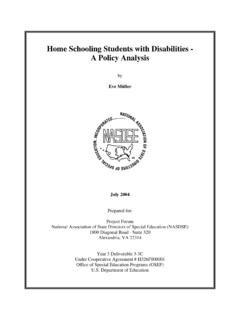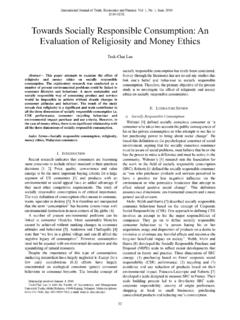Transcription of Response to Intervention - NASDSE.org
1 Response to Intervention NASDSE and CASE White Paper on RtI Introduction This paper is a joint product by the National Association of State Directors of Special Education (NASDSE) and the Council of Administrators of Special Education (CASE) at the Council for Exceptional Children. Our two organizations have joined together to prepare this overview of Response to Intervention (RtI) to share with both general and special educators. It is our goal to engage the general education community in conversations and strategies to provide knowledge and technical assistance to help implement this successful approach to teaching all children, including students with disabilities.
2 The Importance of Response to Intervention The reauthorization of the Individuals with Disabilities Education Act in 2004 (IDEA 2004) focused national attention on a growing successful practice in the general education classroom RtI as a tool for assessing and working with struggling learners. IDEA 2004 brings new interest to the use of RtI because of major changes made in the law: (1) ..when determining whether a child has a specific learning disability as defined in section 602, a local educational agency shall not be required to take into consideration whether a child has a severe discrepancy between achievement and intellectual [ 108-446, 614(b)(6)(A)] ; (2) In determining whether a child has a specific learning disability, a local educational agency may use a process that determines if the child responds to scientific, research-based Intervention as a part of the evaluation [ 108-446, 614(b)(6)(B)]; and (3) a local education agency may use up to 15% of its federal funding.
3 To develop and implement coordinated, early intervening students in kindergarten through grade 12 (with a particular emphasis on students in kindergarten through grade 3) who have not been identified as needing special education or related services but who need additional academic and behavioral support to succeed in a general education environment [ 108-446, 613(f)(1)]. May 2006 1 Taken together, these three changes provide an exceptional opportunity for general and special educators to work together closely to implement RtI -- the practice of (1) providing high-quality instruction/ Intervention matched to student needs and (2) using learning rates over time and level of performance to (3) make important educational decisions.
4 While the acceptance of RtI as a way of working with struggling learners has been given a boost by IDEA 2004, the purpose of this paper is to stress the importance of RtI for use by general educators. It is, first and foremost, a strategy to be used in the general education classroom. This paper is a call from the special education community to the general education community to join together to commit to a uniform system of education, where RtI plays a key role in identifying and working with struggling learners in any setting and ultimately helps educators make better decisions about which children should be referred for additional targeted supports.
5 This approach builds on two recommendations made by the President s Commission on Excellence in Special Education report, A New Era: Revitalizing Special Education for Children and Their Families: Consider children with disabilities as general education children instruction, the systems must work together to provide effective teaching. Embrace a model of prevention not a model of failure. The current model guiding special education focuses on waiting for a child to fail, not on early Intervention to prevent failure. Reforms must move the system toward early identification and swift Intervention , using scientifically based instruction and teaching methods (Commission Report, p.)
6 9). The Commission also specifically recommended the use of an RtI model. The Commission s recommendation goes on to say: Implement models during the identification and assessment process that are based on Response to Intervention and progress monitoring. Use data from these processes to assess progress in children who receive special education services (Commission Report, p. 21). Just as the No Child Left Behind Act of 2001 (NCLB) has had a profound impact on the inclusion of students with disabilities in the general education curriculum, IDEA 2004 has the potential to have a major impact on how children s progress is monitored in the general education environment and the use of special education as a strategy after other strategies have been used with struggling learners.
7 The intent of RtI is not to layer yet another process on top of existing processes, but rather to utilize RtI to address the challenges and potential of NCLB for improving outcomes for all students, including students with disabilities. It is also important to note that many school districts have implemented strategies that include the components of an RtI process but call them by some other name. These include student progress monitoring and data-based decisionmaking within a problem-solving framework. Throughout this paper, the term RtI is used to encompass all of these programs. Components of Response to Intervention RtI is the practice of providing high-quality instruction and interventions matched to student need, monitoring progress frequently to make decisions about changes in instruction or goals and applying child Response data to important educational decisions.
8 May 2006 2 RtI should be used for making decisions about general, compensatory and special education, creating a well-integrated system of instruction/ Intervention guided by child outcome data. RtI is based on the following core principles: We can effectively teach all children. Intervene early. Use a multi-tier model of service delivery. Use a problem-solving method to make decisions within a multi-tier model. Use research-based, scientifically validated interventions /instruction to the extent available. Monitor student progress to inform instruction. Use data to make decisions. Use assessments for three different purposes: (1) screening applied to all children to identify those who are not making progress at expected rates; (2) diagnostics to determine what children can and cannot do in important academic and behavioral domains; and (3) progress monitoring to determine if academic or behavioral interventions are producing desired effects.
9 Three key components of RtI are: High-quality instruction/ Intervention , which is defined as instruction or Intervention matched to student need that has been demonstrated through scientific research and practice to produce high learning rates for most students. Individual Response is assessed in RtI and modifications to instruction/ Intervention or goals are made depending on results with individual students. Learning rate and level of performance are the primary sources of information used in ongoing decisionmaking. Learning rate refers to a student s growth in achievement or behavior competencies over time compared to prior levels of performance and peer growth rates.
10 Level of performance refers to a student s relative standing on some dimension of achievement/performance compared to expected performance (either criterion- or norm-referenced). Decisions about the use of more or less intense interventions are made using information on learning rate and level. More intense interventions may occur in general education classrooms or pull-out programs supported by general, compensatory or special education funding. Important educational decisions about intensity and likely duration of interventions are based on individual student Response to instruction across multiple tiers of Intervention . Decisions about the necessity of more intense interventions , including eligibility for special education, exit from special education or other services, are informed by data on learning rate and level.






